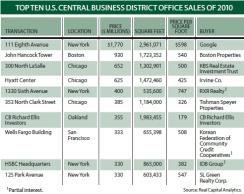In March 2009, when private equity firms Normandy Real Estate Partners and Five Mile Capital Partners bought Boston’s John Hancock Tower at a foreclosure auction for $661 million, approximately 20 percent of the 62-story building’s rentable space was vacant. But Morristown, New Jersey–based Normandy knew the once-venerable office building, New England’s tallest structure, had great potential. So it did extensive renovations and took advantage of the low purchase price to offer attractive lease packages.
Last October, Boston Properties, the real estate investment trust led by billionaire Mortimer Zuckerman, agreed to pay $930 million for the 96 percent-leased tower. “We were not necessarily counting on a resurgent economy or a decline in unemployment to make our investment work,” says Normandy managing principal Jeffrey Gronning.
This deal underscores the turn in U.S. commercial real estate. According to New York–based research and consulting firm Real Capital Analytics, sales hit $134.1 billion in 2010, more than double that of the previous year. December’s $27.4 billion in transactions was the highest one-month total in three years. “We have seen some improvements lately in vacancy rates and increases in valuations of properties,” says Robert Merck, head of agricultural and real estate investments at New York–based Metropolitan Life Insurance Co.

But for the most part, pricing is not recovering. The Washington-based Mortgage Bankers Association notes that one widely followed commercial property price index ended 2010 at 57 percent of its all-time high in 2007, while another finished at 64 percent of peak value.
Driving demand are domestic REITs, real estate families and foreign investors. In a recent survey by Washington’s Association of Foreign Investors in Real Estate, respondents said the U.S. market has the best potential for capital appreciation.
By lending again, banks and life insurance companies are fueling the rebound. In 2010, MetLife almost doubled its originations of real estate loans from the previous year, to $8 billion.
Commercial-mortgage-backed securities have revived too. Thomas Fink, managing director of New York CMBS information provider Trepp, says $16 billion in CMBS debt was issued in 2010. A fraction of the $230 billion in 2007, this sum is still crucial. “The result is greater liquidity in the marketplace, particularly for properties in secondary and tertiary markets,” says Patrick Halter, CEO of Des Moines, Iowa–based Principal Real Estate Investors.
Lenders are willing to finance or refinance well-leased, cash flow–strong properties in top-tier cities like Boston, New York, San Francisco and Washington, as well as Chicago, Los Angeles and Seattle. Merck says that Dallas and Houston also look promising.
Experts are most bullish on multifamily properties, whose shorter leases make them better candidates for rent hikes than strip malls and office buildings. “Apartments tend to bounce back faster from a downturn since people need a place to live,” says Mitch Roschelle, U.S. real estate advisory practice leader at professional services firm PricewaterhouseCoopers.
For office buildings, there is strong interest in trophy properties in New York, San Francisco, Washington and other gateway cities, on the grounds that these centers will lead in job creation.
But commercial real estate has a long way to go, partly owing to a gloomy employment picture. Meanwhile, Roschelle says, $1.4 trillion worth of commercial real estate loans come due in the next four years. Their value often exceeds that of the underlying property; with bid-ask spreads still wide, owners are reluctant to sell. Banks extending loan terms also stop the market from hitting what some see as its natural bottom. As those loans come due, they will either hinder recovery or create a big opportunity for investors who refinance the debt.
Still, there are signs that the worst is over for commercial real estate, says Randall Zisler, CEO of Zisler Capital Associates, a Marina del Rey, California–based investment advisory firm: “We expect a significant decrease in uncertainty in the next two years as the general economic recovery strengthens.







